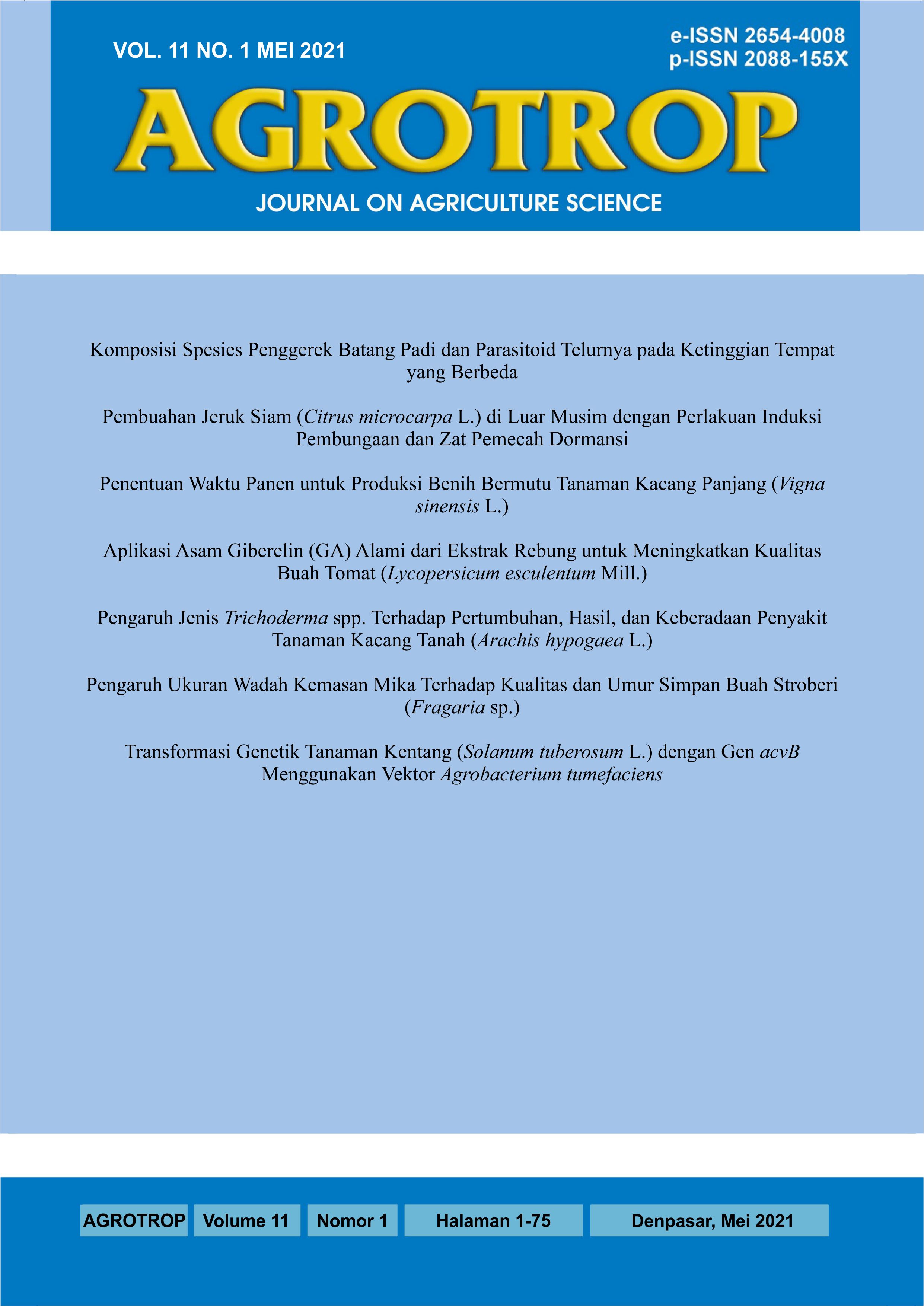Respon Pertumbuhan dan Hasil Tanaman Jagung Manis terhadap Dosis Spora Endomikoriza Indigenus
Abstract
Response of Growth and Yield of Sweet Corn to Dosage of Spores of Indigenous Endomycorrhizae. Endomycorrhizae is a form of mutualism association between fungi (myces) and roots (rhiza) of higher plants. The symbiotic relationship that occurs at the roots is mutually beneficial. Plants can provide carbon organic compounds for fungal growth, whereas fungi benefit plants by increasing nutrient uptake, water, producing enzymes, antibiotics and other compounds given to host plants. The study was conducted to know the effect of dosage of spores of endomycorrhizae indigenous to growth and yield of sweet corn. The experiments were carried out in laboratories and greenhouses. The design used was a completely randomized design with one factor namely the dose of spores of endomycorrhizae consisting of three levels, i.e. D0 = without inoculation of endomycorrhizae, D1 = 75 spores of endomycorrhizae/plant, and D2 = 150 spores of endomycorrhizae/plants. The results showed that dose of spores of endomycorrhizae treatment had a significant effect on growth and yield of sweet corn. The highest fresh weight of cob was obtained at a dose of 150 spores/plant, namely 181.33 g / plant. Based on the results of this study, it is necessary to conduct research in the field using a dose of 150 spores of endomycorrhizae per plant.
Downloads
References
Brundrett, M., Bougher, N., Dell, B., Grove, T., & Malajczuk, N. (1995). Working with mycorrhizas in forestry and agriculture. Pirie Printers, Canberra.
Cahya, J. E., & Herlina, N. (2018). Uji Potensi Enam Varietas Jagung Manis (Zea mays saccharata Sturt) di Dataran Rendah Kabupaten Pamekasan. Jurnal Produksi Tanaman, 6(1), 92–100.
Clemmensen, K. E., Finlay, R. D., Dahlberg, A., Stenlid, J., Wardle, D. A., & Lindahl, B. D. (2015). Carbon sequestration is related to mycorrhizal fungal community shifts during long‐term succession in boreal forests. New Phytologist, 205(4), 1525–1536. https://doi.org/10.1111/nph.13208
Corrales, A., Mangan, S. A., Turner, B. L., & Dalling, J. W. (2016). An ectomycorrhizal nitrogen economy facilitates monodominance in a neotropical forest. Ecology Letters, 19(4), 383–392. https://doi.org/10.1111/ele.12570
FAO. (2020). COVID-19 and Food Safety: Guidance for Food Businesses. https://www.who.int/publications-detail/covid19-and-food-safety-guidance-for-food-business
Habte, M., & Manjunath, A. (1991). Categories of vesicular-arbuscular mycorrhizal dependency of host species. Mycorrhiza, 1(1), 3–12. https://doi.org/10.1007/BF00205896
Herman, D. J., Firestone, M. K., Nuccio, E., & Hodge, A. (2012). Interactions between an arbuscular mycorrhizal fungus and a soil microbial community mediating litter decomposition. FEMS Microbiology Ecology, 80(1), 236–247. https://doi.org/10.1111/j.1574-6941.2011.01292.x
INVAM. (2017). International culture collection of (Vesicular) arbuscular mycorrhizal fungi. West Virginia University, Morgantown, West Virginia.
Ke Lele, O., Rai, I. N., & Suada, I. K. (2018). Uji Efektifitas Endomikoriza Indigenus terhadap Pertumbuhan Tanaman Jagung ( Zea mays L . ) The Effectiveness Test of Indigenous Endomycorrhiza on Maize Plant. 8(1), 20–27.
Mickan, B. S., Abbott, L. K., Stefanova, K., & Solaiman, Z. M. (2016). Interactions between biochar and mycorrhizal fungi in a water-stressed agricultural soil. Mycorrhiza, 26(6), 565–574. https://doi.org/10.1007/s00572-016-0693-4
Mohammadi, K., Shiva Khalesro, Sohrabi, Y., & Heidari, G. (2011). A review: Beneficial effects of the mycorrhizal fungi for plant growth. Journal of Applied Environmental and Biological Sciences, 1(9), 310–319.
Muis, R., Ghulamahdi, M., Melati, M., & Mansur, I. (2013). Diversity of Arbuscular Mycorrhiza Fungi from trapping using Different Host Plants. International Journal of Sciences: Basic and Applied Research, 27(2), 158–169. http://gssrr.org/index.php?journal=JournalOfBasicAndApplied
Musfal. (2008). Efektivitas Cendawan Mikoriza Arbuskula (CMA) terhadap Pemberian Pupuk Spesifik Lokasi Tanaman Jagung pada Tanah Inceptisol. Universitas Sumatera Utara.
Mustfal. (2010). Potensi Cendawan Mikoriza Arbuskula Untuk Meningkatkan Hasil Tanaman Jagung. Jurnal Penelitian Dan Pengembangan Pertanian, 29(4), 154–158. https://doi.org/10.21082/jp3.v29n4.2010.p154-158
Muzar, A. (2006). Respons tanaman jagung (Zea mays L.) kultivar Arjuna dengan populasi tanaman bervariasi terhadap mikoriza vesikular arbuskular (MVA) dan kapur pertanian superfosfat (KSP) pada Ultisol. Jurnal Akta Agrosia, 9(2), 75–85.
Parniske, M. (2008). Arbuscular mycorrhiza: the mother of plant root endosymbioses. Nature Reviews Microbiology, 6(10), 763–775. https://doi.org/10.1038/nrmicro1987
Rai, I. N., Suada, I. K., Proborini, M. W., Wiraatmaja, I. W., SEMENOV, M., & Krasnov, G. (2019). The Indigenous endomycorrhizal fungi at salak (Salacca zalacca) plantations in Bali, Indonesia and their colonization of the roots. Biodiversitas Journal of Biological Diversity, 20(8), 2410–2416. https://doi.org/10.13057/biodiv/d200840
Sastrahidayat, I. R. (2011). Ilmu jamur: (mikologi). Universitas Brawijaya Press.
Simanungkalit, R. D. M., Suriadikarta, D. A., Rasti, S., Diah, S., & Wiwik, H. (2006). No TitlePupuk Organik dan Pupuk Hayati. Balai Besar Litbang Sumberdaya Lahan Pertanian.
Six, J., & Paustian, K. (2014). Aggregate-associated soil organic matter as an ecosystem property and a measurement tool. Soil Biology and Biochemistry, 68, A4–A9. https://doi.org/10.1016/j.soilbio.2013.06.014
Talanca, H. (2010). Status cendawan mikoriza vesikular-arbuskular (MVA) pada tanaman. Prosiding Pekan Serealia Nasional, 353–357.
Veresoglou, S. D., Anderson, I. C., de Sousa, N. M. F., Hempel, S., & Rillig, M. C. (2016). Resilience of Fungal Communities to Elevated CO2. Microbial Ecology, 72(2), 493–495. https://doi.org/10.1007/s00248-016-0795-8











